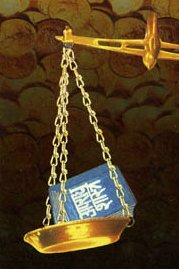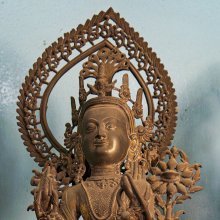Pauranika, Paurāṇika: 21 definitions
Introduction:
Pauranika means something in Hinduism, Sanskrit, the history of ancient India, Marathi, Hindi. If you want to know the exact meaning, history, etymology or English translation of this term then check out the descriptions on this page. Add your comment or reference to a book if you want to contribute to this summary article.
Alternative spellings of this word include Pauranik.
Images (photo gallery)
In Hinduism
Purana and Itihasa (epic history)
Source: Cologne Digital Sanskrit Dictionaries: The Purana IndexPaurāṇika (पौराणिक).—(Purāṇajña)—is Sūta; ancient Purāṇateller;1 on Māndhāta and Hariścandra;2 alias Vaṃśavittama.3
- 1) Brahmāṇḍa-purāṇa III. 8. 83; Matsya-purāṇa 114. 3; Vāyu-purāṇa 45. 71; 70. 76; 88. 67, 114, 168; 101. 72.
- 2) Brahmāṇḍa-purāṇa III. 63. 69, 113.
- 3) Ib. III. 63. 168.

The Purana (पुराण, purāṇas) refers to Sanskrit literature preserving ancient India’s vast cultural history, including historical legends, religious ceremonies, various arts and sciences. The eighteen mahapuranas total over 400,000 shlokas (metrical couplets) and date to at least several centuries BCE.
Arthashastra (politics and welfare)
Source: archive.org: Studies in Kautilya VocabularyPaurāṇika (पौराणिक) refers to a type of profession mentioned in the Śukranītisāra 2.128-188.—The Śukranītisāra is a Sanskrit work on ethics by Śukrācārya comprised of four chapters. The second chapter (uvarājādikṛtya, “the duties of the royal princes and the like”) describes a large number of varied topics, eg., it contains observations on the ministers, priests, sacive, treasury, a large number of officers and employees (such as a Paurāṇika).
Source: Shodhganga: Kakati Ganapatideva and his times (artha)Paurāṇika (पौराणिक) refers to “the brahmana who recites Purana” and represents an official title designating one of the seventy-two officers (niyoga) of the Bāhattaraniyogādhipati circle, according to the Inscriptional glossary of Andhra Pradesh (Śāsana-śabdakośāmu). The bāhattaraniyoga-adhipati is the highest executive officer of this circle (including a Paurāṇika). For example: During the reign of Gaṇapatideva, the area extending between Pānagal to Mārjavāḍi was entrusted to Gaṇḍapeṇḍāru Gangayasāhiṇi as Bāhattaraniyogādhipati. Later on, this office was entrusted to Kāyastha Jannigadeva.

Arthashastra (अर्थशास्त्र, arthaśāstra) literature concerns itself with the teachings (shastra) of economic prosperity (artha) statecraft, politics and military tactics. The term arthashastra refers to both the name of these scientific teachings, as well as the name of a Sanskrit work included in such literature. This book was written (3rd century BCE) by by Kautilya, who flourished in the 4th century BCE.
Ayurveda (science of life)
Source: gurumukhi.ru: Ayurveda glossary of termsPaurāṇika (पौराणिक):—Versed in ancient legends and stories

Āyurveda (आयुर्वेद, ayurveda) is a branch of Indian science dealing with medicine, herbalism, taxology, anatomy, surgery, alchemy and related topics. Traditional practice of Āyurveda in ancient India dates back to at least the first millenium BC. Literature is commonly written in Sanskrit using various poetic metres.
Shaivism (Shaiva philosophy)
Source: ORA: Amanaska (king of all yogas): (Shaivism)Paurāṇika (पौराणिक) refers to “those versed in the Purāṇas”, according to the Dakṣiṇāmūrti (Dakṣiṇāmūrtistotrabhāvārthavārttika), otherwise known as the Mānasollāsa and attributed to a Sureśvarācārya.—Accordingly, while discussing the thirty-six Tattvas of Śaivism: “Those who know the scriptures of Sāṅkhya know twenty-four Tattvas. Those versed in the Purāṇas [i.e., paurāṇika] teach thirty Tattvas [which are] Mahat, Kāla, Pradhāna, Māyā, Vidyā and Pūruṣa along with the [twenty-four of Sāṅkhya]. Experts on the Śaivāgamas speak of thirty-six, [the six additional ones being,] Bindu, Nāda, Śakti, Śiva, Śānta and finally Atīta”.

Shaiva (शैव, śaiva) or Shaivism (śaivism) represents a tradition of Hinduism worshiping Shiva as the supreme being. Closely related to Shaktism, Shaiva literature includes a range of scriptures, including Tantras, while the root of this tradition may be traced back to the ancient Vedas.
General definition (in Hinduism)
Source: Hindupedia: The Hindu EncyclopediaIn the Paurānika trimurty concept, Brahma, Viṣṇu and Rudra preside over creation, sustenance and dissolution functions. They are representatives of Śatva, Rajas and Tamas. According to Yāska, they derive from the Vedic triplet Agni (Fire God), Āditya (Sun God) and Vāyu (Air God).
India history and geography
Source: Cologne Digital Sanskrit Dictionaries: Indian Epigraphical GlossaryPaurāṇika.—(EI 30; BL), a reciter of the Purāṇas; also pro- bably, an astrologer. Cf. Vyāsa. Note: paurāṇika is defined in the “Indian epigraphical glossary” as it can be found on ancient inscriptions commonly written in Sanskrit, Prakrit or Dravidian languages.

The history of India traces the identification of countries, villages, towns and other regions of India, as well as mythology, zoology, royal dynasties, rulers, tribes, local festivities and traditions and regional languages. Ancient India enjoyed religious freedom and encourages the path of Dharma, a concept common to Buddhism, Hinduism, and Jainism.
Languages of India and abroad
Marathi-English dictionary
Source: DDSA: The Molesworth Marathi and English Dictionarypaurāṇika (पौराणिक).—m (S) A Brahman well-read in the Puran̤s; or a public expounder of them.
Source: DDSA: The Aryabhusan school dictionary, Marathi-Englishpaurāṇika (पौराणिक).—m A Bra'hman well-read in the Pura'ns;or a public expounder of them. n Virility. Strength, power, vigour.
Marathi is an Indo-European language having over 70 million native speakers people in (predominantly) Maharashtra India. Marathi, like many other Indo-Aryan languages, evolved from early forms of Prakrit, which itself is a subset of Sanskrit, one of the most ancient languages of the world.
Sanskrit dictionary
Source: DDSA: The practical Sanskrit-English dictionaryPaurāṇika (पौराणिक).—a. (-kī f.) [पुराण-ठक् (purāṇa-ṭhak)]
1) Belonging to the past, ancient.
2) Belonging to the Purāṇas or derived from them.
3) Versed in the legends of the past.
4) Versed in the science of architecture (śilpaśāstra); Mahābhārata (Bombay) 1.51.15 (com.).
-kaḥ 1 A Brāhmaṇa well-versed in the Purāṇas, a public reader of the Purāṇas.
2) A mythologist.
Source: Cologne Digital Sanskrit Dictionaries: Shabda-Sagara Sanskrit-English DictionaryPaurāṇika (पौराणिक).—mfn.
(-kaḥ-kī-kaṃ) Of or belonging to the Puranas, Pauranic. m.
(-kaḥ) A Brahman, well read in the Puranas, a mythologist. E. purāṇa, and ṭhak aff.
Source: Cologne Digital Sanskrit Dictionaries: Benfey Sanskrit-English DictionaryPaurāṇika (पौराणिक).—i. e. purāṇa + ika, adj., f. kī. 1. Relating to past ages, old, [Prabodhacandrodaya, (ed. Brockhaus.)] 13, 5. 2. Conversant with the events of former times, Mahābhārata 1, 851.
Source: Cologne Digital Sanskrit Dictionaries: Cappeller Sanskrit-English DictionaryPaurāṇika (पौराणिक).—[feminine] ī = [preceding], also knowing the past.
Source: Cologne Digital Sanskrit Dictionaries: Monier-Williams Sanskrit-English Dictionary1) Paurāṇika (पौराणिक):—[from paurāṇa] mf(ī)n. idem, [Kāvya literature; Purāṇa; Suśruta]
2) [v.s. ...] versed in ancient legends and stories, [Mahābhārata] (cf. [Patañjali on Pāṇini 4-2, 60])
3) [v.s. ...] of the value of one Purāṇa (coin), [Saṃskārakaustubha]
4) [v.s. ...] m. a Brāhman well read in the Purāṇas, a mythologist, [Horace H. Wilson]
Source: Cologne Digital Sanskrit Dictionaries: Yates Sanskrit-English DictionaryPaurāṇika (पौराणिक):—(kaḥ) 1. m. A brāhman well read in the Purānas. a. Purānic.
Source: DDSA: Paia-sadda-mahannavo; a comprehensive Prakrit Hindi dictionary (S)Paurāṇika (पौराणिक) in the Sanskrit language is related to the Prakrit word: Porāṇiya.
[Sanskrit to German]
Sanskrit, also spelled संस्कृतम् (saṃskṛtam), is an ancient language of India commonly seen as the grandmother of the Indo-European language family (even English!). Closely allied with Prakrit and Pali, Sanskrit is more exhaustive in both grammar and terms and has the most extensive collection of literature in the world, greatly surpassing its sister-languages Greek and Latin.
Hindi dictionary
Source: DDSA: A practical Hindi-English dictionaryPaurāṇika (पौराणिक) [Also spelled pauranik]:—(a) mythological; pertaining/belonging to the Puranas (see); (nm) one who is conversant with the Puranas; —[kathā] mythological tale, legend; ~[tā] mythological character.
...
Kannada-English dictionary
Source: Alar: Kannada-English corpusPaurāṇika (ಪೌರಾಣಿಕ):—
1) [adjective] of or in time long past; ancient.
2) [adjective] relating to Purāṇas, the Hindu myuthological works.
--- OR ---
Paurāṇika (ಪೌರಾಣಿಕ):—
1) [noun] that which belongs to Purāṇas, the Hindu mythological works.
2) [noun] a man who discourses, interpretes Purāṇas.
Kannada is a Dravidian language (as opposed to the Indo-European language family) mainly spoken in the southwestern region of India.
See also (Relevant definitions)
Starts with: Pauranika purushottama, Pauranikamatam, Pauranikan.
Full-text (+13): Paurani, Pauratana, Saurapauranikamatasamarthana, Deshavibhaga, Poraniya, Pauranika purushottama, Savarṇika, Puranika, Pauranikamatam, Pavuranikan, Paramparyopadesha, Paurana, Itikacam, Sarat, Pauranikan, Pauranik, Sharad, Vyasa, Puranikan, Itihasa.
Relevant text
Search found 38 books and stories containing Pauranika, Paurāṇika; (plurals include: Pauranikas, Paurāṇikas). You can also click to the full overview containing English textual excerpts. Below are direct links for the most relevant articles:
Garga Samhita (English) (by Danavir Goswami)
Verse 1.12.36 < [Chapter 12 - Description of Śrī Nanda’s Festival]
Verse 8.13.91 < [Chapter 13 - A Thousand Names of Lord Balarāma]
The Shiva Purana (by J. L. Shastri)
Chapter 1 - The discussion among Vyāsa, Śaunaka and others < [Section 6 - Kailāsa-saṃhitā]
Chapter 9 - The mode of interpreting the Praṇava < [Section 6 - Kailāsa-saṃhitā]
Chapter 1 - Origin of the sacred lore < [Section 7.1 - Vāyavīya-saṃhitā (1)]
Brihad Bhagavatamrita (commentary) (by Śrī Śrīmad Bhaktivedānta Nārāyana Gosvāmī Mahārāja)
Verse 2.1.109 < [Chapter 1 - Vairāgya (renunciation)]
Nirvikalpaka Pratyaksha (study) (by Sujit Roy)
Animal Kingdom (Tiryak) in Epics (by Saranya P.S)
The Bhagavata Purana (by G. V. Tagare)
Chapter 9 - Yudhiṣṭhira’s Acquisition of Kingdom < [Book 1 - First Skandha]
Chapter 11 - Kṛṣṇa’s Entrance into Dvārakā < [Book 1 - First Skandha]
Chapter 4 - Arrival of Nārada < [Book 1 - First Skandha]
